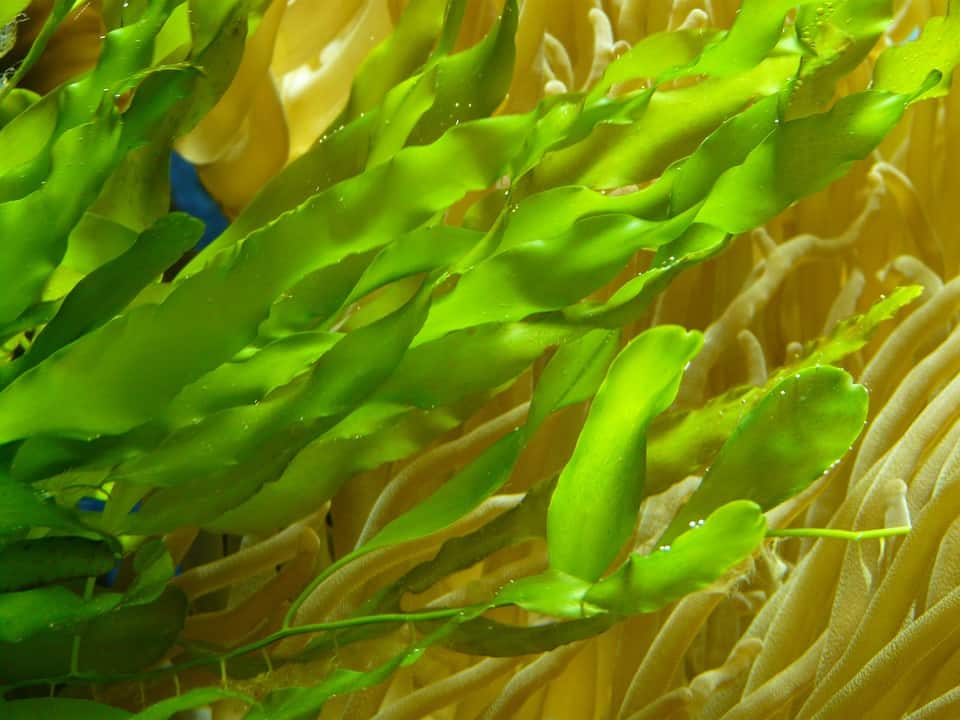When picking up your betta from the pet store, you may have seen a package of betta bulbs on the shelf. If you’ve been wanting to start a planted betta fish tank, then it could be a fun experiment to place some betta bulbs in your aquarium. These bulbs grow into beautiful green plants that can quickly fill up the extra space. If you’re lucky enough, you might even get a flower.
Keep reading to find out everything you need to know about betta bulbs and keeping one of these plants in your own aquarium!
What are betta bulbs?
Botanically, bulbs are specialized stems that plants use for storing food during dormant periods; these plants can either be annuals or perennials; meaning that, respectively, a new bulb will either need to be planted every year or the same bulb will flower every year.
When purchasing a betta bulb, all that is included in this specialized stem loaded with food that is ready to be planted and grown. When placed in ideal conditions, the bulb will then grow long leaves and potentially produce one flower. Most betta bulbs grow into a species of Aponogeton, though many bulbs end up being a hybrid species that cannot be easily identified if at all.
Aponogeton sp.
All members of Aponogeton are aquatic plants. Currently, there are close to 60 different species of Aponogeton throughout their native tropical waters of Asia, Africa, and Australia.
These flowers are usually found in still or slow-moving areas of water and are usually submerged for the full year. However, in drought and wavering temperature conditions, they have the ability to reduce to a bulb and enter a dormant state until ecological conditions prompt growth again. These bulbs are able to be readily transported and replanted as they have a very high resistance to drying out.
If successful, Aponogeton bulbs usually sprout into tall, broad green leaves. If your plant is especially happy, it might even form an emersed flower that may be white or purple.
Tank conditions & planting bulbs
Aponogeton bulbs don’t require too much additional tank maintenance or high tech setup, making them one of the easier live plants for betta tanks as long as they successfully sprout first.
Most members of this species are tropical, apart from A. madagascarensis, and will do best in water temperatures between 72-82° F (22.2-27.8° C). Water pH should be neutral, around 6.5-75; water current should be minimal in order to recreate their natural ecosystems. No special lighting is required, though they may grow better under higher intensities and more exact spectrums. Fertilizers and additional CO2 are also not necessary, though growth rates may increase with supplementation.
In order to plant your bulbs, you will want to find allow enough space between them; the substrate should also be 2-3 inches (5.1-7.6 cm) deep to ensure that the roots have enough space and are away from other plants. The bulbs should then be planted halfway into the substrate; if roots have already begun to sprout, then just make sure to cover the roots instead of the whole bulb. If there are no signs of growth within the first week, monitor for rot and decay and remove immediately if present.
How long does it take for an aquarium plant blub to grow?
Betta bulbs are a popular choice for experiencing plant growth from start to finish. Aponogeton sp. grows rather quickly and can fill out a small tank in a matter of weeks.
However, many hobbyists have varying luck with getting their betta bulb to grow, and most end up with a dud and/or a moldy bulb. If you find that your Aponogeton bulbs have no new growth after a week, it may be best to remove it from the tank. Otherwise, these bulbs can quickly rot and start to affect water parameters and livestock.
Luckily, most companies that sell betta bulbs offer a 30-day warranty; if your betta bulbs just aren’t growing, first make sure the check the back of the packaging and see if the company will replace them!
What plants can a betta fish live with?
There is some discussion about whether betta fish can be kept with live plants or not, but plants tend to do more good than bad in the long run. There are a few stories of bettas nipping at roots and leaves, but usually, that plant is already starting to decay or the betta does not have enough stimulation; remember, bettas are carnivores and shouldn’t go after your plants.
While you can put almost any kind of freshwater aquarium plant you want in with your betta, some species seem to grow a little better in betta tanks specifically:
- Java fern (Vesicularia dubyana/Taxiphyllum barbieri)
- Anubias sp.
- Cryptocoryne sp.
- Water wisteria (Hygrophila difformis)
- Anarcharis (Elodea genus)
- Marimo moss ball (Aegagropila linnaei; species of algae)
Most of these plants are considered low tech, meaning that they don’t require much to any additional care at all! In fact, most of these plant species are successfully grown under stock aquarium fluorescent lighting with little to no problems; additional CO2 and/or fertilizers are usually not necessary either. A more high-quality light system will probably lead to more growth but is not necessary at all for keeping these species.
If you feel like seeing your plants grow with your tank, betta bulbs will help mark the life of your ecosystem. Of course, betta bulbs may also be introduced to an established planted betta tank or any other kind of freshwater system that has plant-compatible tank mates.
For a full list of the best live plants for betta fish, make sure to check out our guide here!
Do bettas need real plants?
As with any fish, bettas don’t need plants to thrive. However, plant maintenance is usually minimal and there are many benefits to keeping live plants in betta tank systems, like aeration, nutrient export, and natural beauty.
Aeration. Plants are autotrophic and make food for themselves through photosynthesis. This is the process of converting carbon dioxide and water into sugars (glucose) and oxygen with the help of a light source. Betta fish do the opposite of this and respire, converting sugars (glucose) and oxygen to carbon dioxide and water.
Together, plants help introduce more oxygen into the tank for fish to breathe; this is especially useful in tanks that have limited surface agitation and inadequate gas exchange.
Nutrient export. One of the big reasons that hobbyists get plants for their tank is for nutrient export. Plants need nutrients in order to grow, with some of the big ones being nitrates and phosphates. These two nutrients usually cause the most headaches for fishkeepers as they are responsible for most algae outbreaks due to overfeeding, poor tank maintenance, or other reasons.
If the plant to betta bioload ratio is even, there will rarely be a problem with excess nutrients; heavily planted tanks are one of the ways to avoid having a filter on the system as the plants will take up a good portion of the nutrients that are created. However, we still recommend having a filter on your tank to help move the water around and introduce more oxygen into the system.
Beauty. Last but not least, plants add natural beauty to the tank. Plant species range in size and color and can be used to create a mini underwater jungle. Not only are plants beautiful, but fish will also love the additional shade and shelter; betta fish especially are known for resting on the leaves of plants from time to time.
Conclusion
Betta bulbs are a fun experiment and do not require a high tech planted tank system. However, hobbyists have found that most betta bulbs do not grow, which can lead to them rotting in the tank. If you are lucky enough for your plant to grow, you will most likely end up with a hybrid of Aponogeton, though there are a few other species that are also commonly sold as betta bulbs.
If you have any questions about betta bulbs, planted tanks, or have had experience growing betta bulbs in your own freshwater system, don’t hesitate to leave a comment below!











